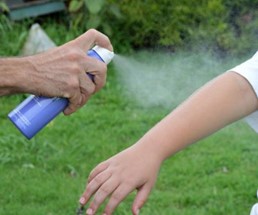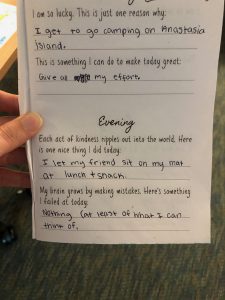by Claire Davis | Nov 3, 2022
 With the holiday season fast approaching, everyone’s favorite dishes will soon appear on the dinner table. Everyone has different taste buds, so that means everyone has different favorite dishes. I know that I am looking forward to sweet potato soufflé and deviled eggs, but I could definitely do without the cranberry sauce. Unfortunately, many parents find themselves in a bind trying to feed their picky eaters. Remember, you are not alone in this battle, and try not to get too frustrated by this typical behavior. This article includes some tips on what to avoid and strategies to help your favorite picky eater!
With the holiday season fast approaching, everyone’s favorite dishes will soon appear on the dinner table. Everyone has different taste buds, so that means everyone has different favorite dishes. I know that I am looking forward to sweet potato soufflé and deviled eggs, but I could definitely do without the cranberry sauce. Unfortunately, many parents find themselves in a bind trying to feed their picky eaters. Remember, you are not alone in this battle, and try not to get too frustrated by this typical behavior. This article includes some tips on what to avoid and strategies to help your favorite picky eater!
DO:
Eat family style. Trying sharing a meal together, as a whole family, as often as you can. This means sitting at a table and turning off the distractions like TV, radio, or cell phones at mealtime. When preparing for your family’s well-balanced meal, incorporate at least one food you know that your picky eater likes. Eating family style also allows for you to set a good example! That squash on your plate may not look appetizing to your picky eater, but if they see you try it, they may be more apt to as well!
Try, try again! Just because a picky eater refuses different foods once, doesn’t mean they won’t ever like it. Keep offering new foods and those your picky eater didn’t like before. It can take as many as seven times to taste food before your taste buds accept it. I can remember as a child disliking anything colored with green vegetables. This could have been salad, peas, green beans, lima beans, or another vegetable. As an adult, I have come to enjoy all of these vegetables and many more! If I had not tried them again, I still may not know if I like them or not.
Make food fun. There are many ways to accomplish this. Youth are typically open to trying foods arranged in eye-popping, creative ways. Make foods look irresistible by arranging them in fun, colorful shapes they can recognize. Finger foods and foods that you dip are also a big hit! Try involving your picky eater in meal planning and prep. Let them pick which fruit and vegetable to add to dinner, or pick them out at the grocery store. Read kid-friendly cookbooks together and let them pick out new recipes to try. Involve them in some of the cooking tasks, such as sifting, stirring, counting ingredients, or picking garden fresh herbs or vegetables.
Finding the right pair. When serving unfamiliar foods, pair the food with something that is familiar. Many picky eaters will not try broccoli alone, but if you add cheese to it, it becomes a whole new dish!
DON’T:
Fight over food. If your picky eater refuses to eat their meal, avoid making a hassle over it. It is important for individuals to learn to listen to their bodies, which will tell them when they are hungry or not. It is up to the adult to provide the food, and it is the other’s decision to eat. Pressuring them into eating, or punishing them if they don’t, can make them actively dislike foods they may otherwise have liked.
Bribes. This goes along with fighting over their food. While it may be tempting to bribe your picky eater to try something, this is not how food should be handled. Bribing to eat the “yucky” food makes the “prize” food that much more exciting. This can lead to future trouble at the dinner table.
Sources:
https://www.healthychildren.org/English/ages-stages/toddler/nutrition/Pages/Picky-Eaters.aspx
by Julie Pigott Dillard | Aug 11, 2022
 What is a Growth Mindset?
What is a Growth Mindset?
A vital skill we encourage in 4-H youth is to set goals and objectives to reach those goals. But what happens when they face a challenge that’s hard and scary or when they fail? With so much emphasis placed on achievement, success, and winning, is it possible for us to grow through challenges or failures? Absolutely! And 4-H provides opportunities to do just that. 4-H uses several theories, models, and frameworks to “do” positive youth development. One of the models we use is the 4-H Thriving Model (Arnold, 2018). This model describes what happens when 4-H programs provide the conditions for youth to explore their sparks in a safe environment and are supported by positive relationships with adults and other youth. One of the concepts related to the 4-H Thriving Model is the growth mindset. According to Carol Dweck (2006), our mindset can contribute to our success or our failure. You can think of the mindset as a spectrum. On one end is the fixed mindset and on the other end is the growth mindset.
First, let’s look at the opposite mindset – the fixed mindset and its tendencies:
- Avoids challenges
- Quits/gives up quickly or easily
- Negative self-image/self-talk
- Effort is pointless
- Avoids or ignores feedback or criticism
- Resentful of other’s successes
- Critical and judgmental of others
- Places blame elsewhere/makes excuses.
Conversely, the growth mindset and its tendencies might look like this:
- Embraces challenges
- Doesn’t give up easily/charges ahead
- Is realistic but compassionate to self
- Effort is part of the journey
- Learns from feedback and criticism
- Is inspired by and celebrates the successes of others
- Helpful and caring to others
- Looks for and believes in possibilities.
Why is a Growth Mindset Important?
Youth and adults who have a growth mindset are more motivated to learn, have better relationships, and are more resilient. As individuals, we all fall somewhere on the mindset spectrum. Sometimes we may have a fixed mindset in one area (such as public speaking) but have a growth mindset in another area (such as being a good writer). I’ve seen both mindsets played out many times in the livestock show arena, at shotgun matches, at the Chick Chain poultry show, and at the tailgate grilling contest. One of my senior 4-Hers came in second place in Chick Chain showmanship. Instead of being upset about not winning, his comment was,
“[4-Her] was really good. I learned a lot by watching him, so I know what to practice for next year.”
On the opposite side, I’ve overheard kids (and parents) exclaim something like ‘there’s no use in showing a pig because nobody can beat [4-Her].’ How could you encourage the growth mindset in that moment? By saying something like, “So what can you do differently? Besides winning, what else are you learning?”
As 4-H professionals and volunteers, we can support the development of a growth mindset to help youth thrive. Knowing where youth fall on the mindset spectrum can help you design and scaffold 4-H experiences to develop a growth mindset over time. For example, if we go back to the example of a youth who has a fixed mindset that they are bad at public speaking. As a caring adult, look for other ways that youth can develop confidence in communicating with others. Encourage them to start by using their spark (such as photography, art, or poetry) to communicate with others and share their project experiences. As they become more confident, encourage them to prepare exhibits, deliver team demonstrations, or even serve in a leadership position as an officer or committee chair.
Digging Deeper
Do you know where you are on the mindset spectrum? Before we can help youth thrive, we need to know whether we have a growth mindset or a fixed mindset. Take this assessment to determine where you fall on the mindset spectrum http://blog.mindsetworks.com/what-s-my-mindset.
To learn more about growth mindset, I highly recommend Mindset: The New Psychology of Success by Carol S. Dweck, PhD. I challenge you to implement these tips with your 4-Hers this year!
References:
Arnold, M. E. (2018). From context to outcomes: Adolescent thriving in 4-H Youth Development Programs. Journal of Human Science and Extension, 6(1), 141-160.
Dweck, C. S. (2006). Mindset: The new psychology of success. Random House.
by pmdavis | Jul 1, 2022
It’s hard to believe the 4th of July is already upon us!

Youth learning to grill during 4-H tailgate program
Many of us will be celebrating with picnics, cookouts, and family get-togethers. One of my colleagues in Clay County, Samantha Murray, did a great article about preventing food poisoning while celebrating. Our youth have also been attending grilling summer camp programs and learning many of these tips plus lots more. The youth have learned about how to use a grill safely, how to prepare food safely and prevent cross-contamination or food-borne illness, and the nutritional benefits of animal protein in diets. Our district will have its annual competition to advance to the state-level competition on July 30 at the Washington County Extension Office, in Chipley, Florida.
I just wanted to take a moment to recap the tips Samantha gave to keep all of us safe and healthy while celebrating.
- Keep raw meats in a separate cooler than ready-to-eat items or beverages.
- Foods with mayonnaise are less acidic creating a better environment for bacterial growth
- Chicken and ground beef needs to be cooked to 165°F
- Wash hands if soap and water are not available use hand sanitizer to reduce the risk of contaminating food.
- Use different tongs or spatulas for cooked and uncooked meat or wash them after being in contact with raw meat.
- It is recommended to refrigerate leftovers within two hours unless it’s really hot, then the window shrinks to about an hour.
Other items you may want to think about.
- Keep beverages in a separate cooler from other foods, people will be going in and out of beverage coolers much more keeping the temperature higher and allowing bacterial growth.
- Cook cuts of pork, beef, or shrimp to 145°F
- Don’t sit charcoal grills on plastic tables and make sure the area is free from debris that can catch fire, including limbs or tents overhead.
- Clean up after yourself leaving only footprints in the area you were in!
- Enjoy time with friends and family safely!
For more information about educational programs, check out our webpage or contact your local UF IFAS Extension Office.
by Niki Crawson | May 20, 2022
Summer is right around the corner. As much as we all love the sunshine feeling on our face and body, too much of a good thing can be harmful! It is always important to remember our family’s well-being, take responsibility for our personal safety, and make healthy decisions, even while having a fun time. Here are some short sun safety reminders to make your summer a fun and enjoyable experience for you and your family members!
SUN SAFETY
Plan Your Day Around the Clock
The sun shares its most harmful rays in the middle of the day so plan this time for indoor use. The sun’s rays are most harmful between the hours of 10 AM and 4 PM so make outdoor time in the early morning or early evening when it is less intense. This also keeps your food at safer temperatures as well so your ice (or you) won’t melt as fast.
Protect Your Body

Look for SPF 30 or higher sunscreen.
One of the easiest defenses against the sun is sometimes one of the most forgotten, sunscreen! Be sure to lather up in sunscreen BEFORE you go outside. The American Academy of Dermatology recommends liberally applying a sunscreen that is at least SPF 30 or higher, as these formulas will block UVA and UVB rays. Be sure to apply at least 30 minutes prior to going outside. Once outside, continue to apply sunscreen every two hours or after swimming. Not sure what kind of sunscreen blocks UVA and UVB rays? Look for a sunscreen that is SPF 30 or higher with the ingredients zinc oxide or titanium dioxide as these ingredients will do the job. Remember to coat your ears, neck, tops of feet, etc.
Remember to grab your sunglasses too! Your eyeballs are just as sensitive as your skin so blocking UVA and UBA rays from your eyes are important to. Fashionable sunglasses are great if you are into that but being able to protect your eyes is the goal.
Limit Time

Remember to keep your pets cool too!
Most everyone enjoys getting outside this time of year to soak up some sunshine and enjoy the beautiful day. In fact, it’s true that some amount of sunlight is healthy for your body and mind. However, as we know all too well sometimes, too much exposure can be detrimental and lead to sunburn, heat exhaustion and more. Thus, it is a good idea to find balance by setting a time limit on sun exposure, if possible. If time slips past you because you and your family are having too much fun, set an alarm as a friendly reminder. Make this your “shade time” for a water break, game of cards, or a brief nap. Be sure to always have an umbrella or tent on hand in case no shade is available.
Hydrate
It is very easy to get dehydrated in the summertime. Drink water throughout the day. Don’t wait until you get hot and thirsty. Drink water to maintain your hydration before it is depleted. This will help avoid those nasty summer headaches and tummy aches. Taking your pet with you? Don’t forget Fido’s water bowl too!
4-H PROGRAMMING
UV Bead Activity
Looking for a really cool lesson to teach your children about the risk factors associated with sun exposure and UV rays? Check out this 4-H activity 4-H + Me = Health: Sun Safety from Minnesota Extension Service’s Exploring Your Body, Helper’s Guide. In this activity, children can make their own beaded bracelets that change colors when exposed to UV light. This is a great way for children to understand UV light, cloud coverage, sunscreen SPFs and more!

UV Beads with no sun exposure.
4-H has plenty of educational programming, both outdoors and indoors, to keep your children engaged this summer! From gardening to robots, archery to grilling, 4-H has something for everyone. If you are looking for fun, educational activities during the summer while maintaining a safe environment for your child, please contact your local UF IFAS County Extension Office, or visit http://florida4h.org

UV Beads with sun exposure.
by Rachel Pienta | Jan 21, 2022
 Healthy Living is one of the 4-H’s. While your club may not specifically focus on what is traditionally considered to be “healthy living” activities, you might be surprised about much your 4-H club is contributing to the mental and physical well-being of youth members. After we recognize that all our clubs have a role to play in implementing healthy living strategies across the county 4-H program, we can start to consider ways to be intentional in how we incorporate healthy living into 4-H activities and projects.
Healthy Living is one of the 4-H’s. While your club may not specifically focus on what is traditionally considered to be “healthy living” activities, you might be surprised about much your 4-H club is contributing to the mental and physical well-being of youth members. After we recognize that all our clubs have a role to play in implementing healthy living strategies across the county 4-H program, we can start to consider ways to be intentional in how we incorporate healthy living into 4-H activities and projects.
What does a 4-H Healthy Living program include? A 4 H Healthy Living program or strategy is any activity or program component that can help youth lead lives that balance physical, mental, and emotional health.
According to the National 4-H Council, 4-H Healthy Living programs include objectives that can help “empower youth to be healthy – body and mind – with the skills to make healthy decisions and lead healthy lifestyles. Having the confidence and skills to lead healthy lifestyles not only improves overall well-being; it enables youth to tackle life’s challenges today and become leaders in their lives, careers, and communities as they grow into responsible adulthood” (National 4-H Council, 2021). Your club focus might fit into one of the following program areas: mind, body, leadership, or mentorship.
As a club leader, you may encourage your youth to adopt goals and projects that will cover multiple program areas. Introducing healthy living during club meetings is another way to incorporate these concepts and help youth develop healthier habits.
With so many possible topics to consider, it may seem overwhelming to choose a starting point. In this article, a few suggestions will be explored.
Sleep
It may be surprising to learn that youth, like adults, are not getting enough sleep. Regularly missing hours of sleep or experiencing poor sleep quality can contribute to a variety of issues for youth. The Sleep Foundation is one resource to use for tips on how to encourage our 4-H members to adopt better sleep habits (Pacheco, 2021).
Some ideas for helping your 4-H youth learn about the importance of sleep and how to develop better sleep habits include the activities and lessons listed in the links below this paragraph. Consider challenging your youth to set healthy sleep goals for one month. Discuss the potential benefits during your goal setting activity. At the end of the month, discuss how youth felt on days when the sleep goals were met and how they felt on days when they did not meet their goal.
Activity for Teens (Intermediates and Seniors)
University of Wisconsin Extension. 2007. “4-H Get Fit, That’s It. Lesson 2: Are You Getting Enough Sleep.” Link to activity: https://api.ag.purdue.edu/api/DepotWS/File.ashx?t=f&i=98730
Activity for Elementary School Age (Juniors 4-H Members)
The Nemours Foundation. 2015. Sleep. Kids’ Health in the Classroom.
https://classroom.kidshealth.org/classroom/3to5/body/functions/sleep.pdf
Hydration
One way to incorporate a healthy living strategy into your 4-H program is offering water at all your meetings and limiting the inclusion of other beverages. A 4-H lesson on hydration can include STEM principles as youth can calculate their daily water needs based on their body weight. A fun way to encourage water consumption is to personalize reusable water bottles as a club activity and to award points to youth who remember to bring their bottles to meetings and activities.
All Ages Lesson and Activity
National 4-H Council.2020. How Much Water Do You Need? 4-H Healthy Living Activity Guide.
https://4-h.org/wp-content/uploads/2019/04/4H-Healthy-Living-Activity-Guide.pdf
Other Ways to Incorporate Healthy Living into Your Club Programs
Activities designed to improve sleep and hydration are only two of many possible ways to incorporate healthy living into your 4-H program. Healthy Living activities can incorporate exercise, nutrition, and ways to improve and maintain mental health.
Resources
Caruso, L.; Shelnut, K.; Kauwell, G. 2017. Hydration Myths. UF/IFAS Extension. Retrieved January 16, 2022 from https://edis.ifas.ufl.edu/publication/FY1409.
National 4-H Council. 2021. Healthy Living. Retrieved January 16, 2022 from https://4-h.org/parents/healthy-living/.
Pacheco, D. 2021. Children and Sleep. The National Sleep Foundation. Retrieved January 16, 2022 from https://www.sleepfoundation.org/children-and-sleep.
University of California 4-H Youth Development Program. 2022. Sleep for Better Living. Retrieved January 16, 2022 from https://4h.ucanr.edu/Projects/HealthyLiving/Sleep_for_Better_Living/
by Allison Leo | Jan 6, 2022
The holidays are a joyous and wonderful time of year, but can also be very busy time, and at times, overwhelming. Now that we are back it is time to Children shift into the organized, orderly school day from that unstructured holiday break schedule. As a result, it is inevitable that children may feel some degree of stress from these transitions. Children and teens are still learning to regulate emotions, making them more susceptible to change’s resulting in stress.
Mindfulness is the act of creating awareness of your surroundings, emotions, and physical self in the present moment. It helps you connect to the world around you, while providing cognitive, social, and emotional benefits. Practicing mindfulness is not just for adults. Children can reap a multitude of benefits from learning and practicing mindfulness. Mindfulness equips children with the ability to adjust and deal with conflict encountered in their daily lives. It can also help children foster an optimistic outlook in life, react to stress in a healthy way, and develop a positive self-concept.
The practice of mindfulness is foreign to some adults, making it tricky to teach and model for young children. The best thing to do is keep the message simple and focus on modeling the behaviors. Being taught by an adult that models mindful behaviors daily will assist youth in mastering the techniques. Below are a few mindfulness activities you can do at home as a family or in a group learning environment, such as a 4-H club meeting.
Enjoy Nature
Going on a mindful walk is a simple way to help clear your mind and restore your focus. Taking a nature walk around your neighborhood or park is an easy way to exercise your mindfulness skills and enjoy nature. You can make it exciting by telling them you are going on a “mindfulness safari” and the goal is to see how many different birds, insects, and animals you can find on your journey. Below are some tips for going on a mindful walk:
- Start at a slow pace and gradually increase as the walk continues.
- Pay attention to the feeling in your legs and feet as you take each step. Then, notice how your arms and torso feel as you walk.
- Notice any smells around you.
- Listen to the variety of sounds around you. Notice if the sounds are close or far away.

Talking a walk in nature is a simple way to practice mindfulness Photo by Allison Leo
Meditate
Contrary to what you may think, you do not have to sit silently on the ground with your eyes closed to mediate. You can meditate while you are walking, eating, or doing household chores. The goal of meditation is to slow down and be in the moment. Guided meditation led by a family member are a way to relax and help reduce stress. Below is guided meditation titled “Relationship Fingers” from the University of Minnesota Extension.
Relationship Fingers – Start by holding out your hand with your thumb pointed towards yourself. Take a breath. For each finger we are going to be focusing on a relationship we have with someone. There is no ‘right’ person so don’t worry about who you choose.
- Start by holding your pinky finger and think of someone who is far away from you. Take a breath for them. Really look at that relationship. What do you notice?
- Next focus or touch your ring finger. Think of someone who is leaning on you right now or who may be more vulnerable in this moment. Take a breath for them. Really look at that relationship. What do you notice?
- Hold or focus on your middle finger and think of a leader in your life. Take a breath for them. Really look at that relationship. What do you notice?
- Focus on your pointer finger and think of someone who is close to you. Take a breath for them. Really look at that relationship. What do you notice?
- Last, hold or focus on your thumb. Consider the relationship you have with yourself. Take a good look. What do you notice? What are you committed to? Take one last breath and shake it out.
Gratitude
When we feel and express gratitude to people in our lives, it creates loving connections, builds trust, and makes us feel joyful. Gratitude can be shown by giving someone a hug or telling them how much you appreciate them. Gratitude journals can easily be made at home or you can print off a pre-made template. This version is simple and is a great start for kids: https://researchparent.com/gratitude-journal-for-kids/.
- What’s the best book you’ve ever read? What did you like best about the characters?
- Name one thing that makes you smile every time you hear or see it. Why?
- Describe one thing that made you feel cozy today.
- Who is the one friend you can always rely on?
- What are five things you are looking forward to next year?

Gratitude Journals are a simple mindfulness activity kids can complete every day
Walker, K., Sharpe, K., Anderson, M., Caines, T., Johnson, C., Kennedy, D., Nguyen, K., Odendahl, S., & Santl, K. (2021). Social Emotional Wellbeing: A Guide to Support Youth Thriving. St. Paul: Regents of the University of Minnesota.
 With the holiday season fast approaching, everyone’s favorite dishes will soon appear on the dinner table. Everyone has different taste buds, so that means everyone has different favorite dishes. I know that I am looking forward to sweet potato soufflé and deviled eggs, but I could definitely do without the cranberry sauce. Unfortunately, many parents find themselves in a bind trying to feed their picky eaters. Remember, you are not alone in this battle, and try not to get too frustrated by this typical behavior. This article includes some tips on what to avoid and strategies to help your favorite picky eater!
With the holiday season fast approaching, everyone’s favorite dishes will soon appear on the dinner table. Everyone has different taste buds, so that means everyone has different favorite dishes. I know that I am looking forward to sweet potato soufflé and deviled eggs, but I could definitely do without the cranberry sauce. Unfortunately, many parents find themselves in a bind trying to feed their picky eaters. Remember, you are not alone in this battle, and try not to get too frustrated by this typical behavior. This article includes some tips on what to avoid and strategies to help your favorite picky eater!








